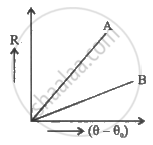Advertisements
Advertisements
प्रश्न
A glass full of hot milk is poured on the table. It begins to cool gradually. Which of the following is correct?
- The rate of cooling is constant till milk attains the temperature of the surrounding.
- The temperature of milk falls off exponentially with time.
- While cooling, there is a flow of heat from milk to the surrounding as well as from surrounding to the milk but the net flow of heat is from milk to the surounding and that is why it cools.
- All three phenomenon, conduction, convection and radiation are responsible for the loss of heat from milk to the surroundings.
उत्तर
b, c and d
Explanation:
When hot milk spreads on the table heat is transferred to the surroundings by conduction, convection and radiation. Because the surface area of poured milk on a table is more than the surface area of milk filled in a glass. Hence, its temperature falls off exponentially according to Newton’s law of cooling. Heat also will be transferred from the surroundings to the milk but will be lesser than that transferred from milk to the surroundings.
APPEARS IN
संबंधित प्रश्न
A body cools from 80 °C to 50 °C in 5 minutes. Calculate the time it takes to cool from 60 °C to 30 °C. The temperature of the surroundings is 20 °C.
On a hot summer day we want to cool our room by opening the refrigerator door and closing all the windows and doors. Will the process work?
A body cools down from 65°C to 60°C in minutes. It will cool down from 60°C to 55°C in
A bucket full of hot water cools from 85 °C to 80 °C in time T1, from 80 °C to 75 °C in time T2 and from 75 °C to 70 °C in time T3, then ______.
A metal sphere cools from 66° C to 57° C in 10 minutes and to 44° C in the next 10 minutes. The ratio of fall of temperature of first 10 minutes to next ten minutes is ____________.
A liquid with a certain surface area takes 10 minutes to cool from 80° C to 70° C. The time taken by it to cool from 80° C to 60° C is [The surrounding temperature being 40° C] ____________.
Newton's law of cooling leads to the expression:
A tub of hot water cools from 80°C to 75°C in time t1 from 75°C to 70°C in time t2, and from 70°C to 65°C in time t3 then:
Two circular discs A and B with equal radii are blackened. They are heated to the same temperature and are cooled under identical conditions. What inference do you draw from their cooling curves?

In 5 minutes, a body cools from 75°C to 65°C at a room temperature of 25°C. The temperature of the body at the end of the next 5 minutes is ______°C.
